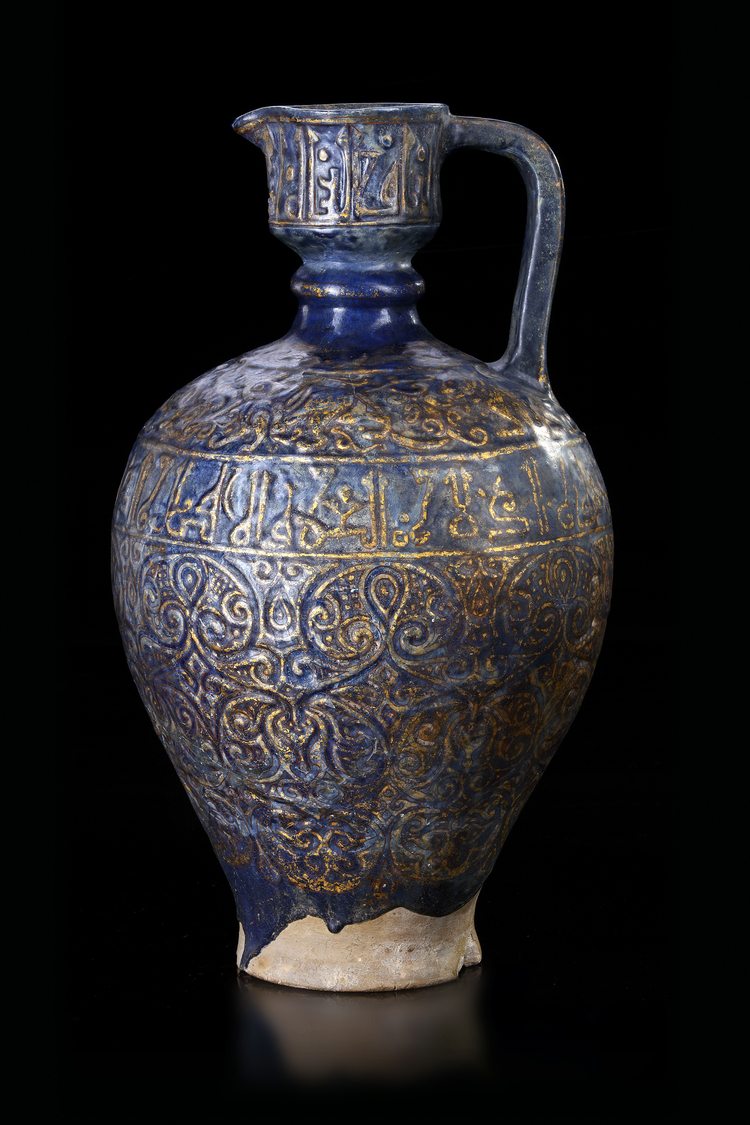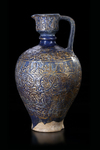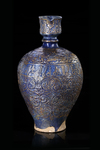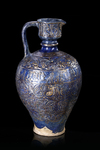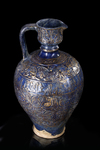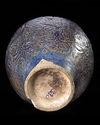* A MONUMENTAL LAJVARDINA POTTERY JUG, ILKHANID PERSIA, 13TH CENTURY
A Persian pottery jug with drop-shaped body and high shoulder rising to a ribbed neck, vertical mouth with small spout and a simple handle. Decorated with gold carved lattice designs interspersed with stylised leaf-motifs on a cobalt-blue ground, beneath a band of angular Kufic inscriptions, shoulder with a band enclosing elegant gilt carved perched bird, a cow and mythical beasts under a band of gilt carved interwined chain. The neck similarly decorated with a band of angular Kufic inscriptions.
Height: 56.5 cm.
Inscriptions
al-'izz wa al-iqbal wa al-dawam wa al-s'ada / al-s'ada wa al-salam li-sahibihi.
'Perpetual Glory and increasing Prosperity, constant Elegance and happiness/ happiness and peace for its owner.
PROVENANCE
Ex. collection Soleiman Morad Pour, Geneva collected between the two world wars.
CATALOGUE NOTE
Lajvardina wares are named after the Persian word lajvard meaning "blue", characterised by their distinctive lapis blue colour. Originally stemming from the Sanskrit word “rajavarta”, a portion of the King, the word lajvard is Persian for lapis lazuli.
It is applied principally to a group of vessels and tiles covered with a very intense cobalt-blue as is seen here, and then decorated in overglaze enamels, often in red, white and gold. As a term is has also been applied to the turquoise glazed enamel decorated vessels and tiles from the same group, as well as the rare examples worked on a white ground. Tiles in this technique are found in buildings dating from the later thirteenth century, notably from Takht-i Sulayman. It continued in use into the Timurid period in Central Asia, although with different designs. The only dated example is a tile formerly in Richard Ettinghausen's collection with the date 1315. For a similar decorated tile we refer to Metropolitan museum accession number: 20.120.73.
- SPECIAL NOTICE This lot is imported from outside the EU for sale using a temporary import regime. Import VAT is payable (at 9%) on the hammer price. The 30% buyers premium is subject to 21% VAT for EU citizens. When the buyer of this is registered an EU address but wishes to export the lot or complete the import into another EU country he must contact Oriental Art Auctions after the auction.
